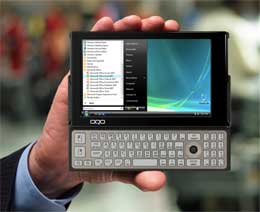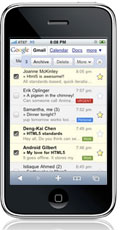 Lotsa Android-related news today:
Lotsa Android-related news today:
Second Android phone finally arrives.
Samsung announces an Android phone.
Here’s the first Android netbook.
Countdown to Kumo (Bing, Hook)?
IBM computer to play Jeopardy.
 Lotsa Android-related news today:
Lotsa Android-related news today:
Second Android phone finally arrives.
Samsung announces an Android phone.
Here’s the first Android netbook.
Countdown to Kumo (Bing, Hook)?
IBM computer to play Jeopardy.
 Things don’t look good for OQO, the company behind a series of handheld computers that ran full-blown Windows. As Eliot Buskirk reports over at Wired.com, the company has lost its CEO and resellers have stopped taking preorders for its next-generation model; rumors are that it’s running out of time to make it as a stand-alone entity.
Things don’t look good for OQO, the company behind a series of handheld computers that ran full-blown Windows. As Eliot Buskirk reports over at Wired.com, the company has lost its CEO and resellers have stopped taking preorders for its next-generation model; rumors are that it’s running out of time to make it as a stand-alone entity.
If OQO folds, it’ll be sad–but the funny thing is that it’s already a pock-marked survivor in the product category of tiny Windows devices. The similar FlipStart PC (backed by Microsoft cofounder Paul Allen) was on the market for only a year. And as far as I can tell, Sony has discontinued its pocket-sized UX handheld. Microsoft’s once-hyped Ultra-Mobile PC (UMPC) platform, meanwhile, is alive but far from thriving.
And yet, the funny thing is that there’s never been more interest in extremely portable computing devices than there is today, nor as many attractive choices. It’s just that very few of them bear much resemblance to the OQO and its direct rivals. Smartphones like the iPhone 3G and T-Mobile G1 are pocket-sized computers by any definition I can imagine; netbooks such as Asus’s Eee PC 1000HE are bigger than the OQO but smaller than garden-variety notebooks.
So how come OQO-class machines have never caught on? I can think of several reasons:
Windows was never designed to run on devices that small. It wants a display with both decent resolution and a fair amount of physical space. They assume the availability of a decent QWERTY keyboard (and I’ve never seen an OQO-class gadget that even had as good a keyboard as I think could be crammed into the available space). They benefit from a mouse, or at least a large touchpad. The whole idea behind these devices is providing the benefits of the world’s most widely-used operating system–such as scads of applications–but the fundamental usability hassles canceled the virtues out for most folks.
They’re full of advanced engineering that didn’t deliver enough user benefit. It’s a small miracle that OQO was able to get full-strength Windows to run on a machine that small at all, and a tribute to the company’s designers. But smartphone engineers have a head start, since they aren’t stuck with the challenge of making a desktop OS run on a tiny device. And netbooks, almost by definition, don’t include any sophistcated engineering–and don’t have to, since they’re large enough that miniaturization isn’t required. (There’s a reason why most netbooks are actually rather chunky.)
They’re too dang expensive. A couple of years ago, the OQO and FlipStart both cost $2000, or more than most people pay for a traditional notebook. Today, OQO starts at a grand. You could buy both a smartphone and a netbook for that, and have money left over.
I know that there are people who are passionate fans of the OQO and similar devices–but there don’t seem to be enough of them to add up to a robust business, and that just isn’t that surprising. Will OQO’s woes scare other companies off from building other computers of this sort? Maybe not: Intel is forging ahead with its Mobile Internet Device platform. I wish it luck. But I’m thinking that consumers have already rendered their verdict–and as usual, theirs is the only one that counts.
 I feel like I should start anything I write about headsets with a disclaimer: I’ve still never met one I can love unreservedly. I have trouble getting them to stay in my ear; I find myself having to futz with buttons and Bluetooth; and sound quality, of course, remains variable. That said, I admire what Aliph has done over the past few years with its Jawbone headset. And tonight the company is announcing Jawbone Prime, a new version that replaces the eleven-month-old Jawbone 2. I’ve only spent a little time with the new model so far, but it aims to improve on its predecessor on all the above fronts: comfort, control, Bluetooth, and sound quality.
I feel like I should start anything I write about headsets with a disclaimer: I’ve still never met one I can love unreservedly. I have trouble getting them to stay in my ear; I find myself having to futz with buttons and Bluetooth; and sound quality, of course, remains variable. That said, I admire what Aliph has done over the past few years with its Jawbone headset. And tonight the company is announcing Jawbone Prime, a new version that replaces the eleven-month-old Jawbone 2. I’ve only spent a little time with the new model so far, but it aims to improve on its predecessor on all the above fronts: comfort, control, Bluetooth, and sound quality.
The basic industrial design hasn’t really changed: It’s still small and stylish (as befits its $130 price). But a new indentation–which is very subtle–makes it a bit easier for your finger to find the button you use for functions such as turning the headset on and off.

Earloops are the bane of my phone-using existence–I can never figure out how to get them over my ear–and while the Jawbone Prime comes with one, it attempts to let most people do without it by providing six rubber earbuds in three different sizes. Three of the buds have a sort of nub that helps to lodge the bud in your ear, and it seems to work well–I was able to shake my head back and forth vigorously without the Jawbone flying out.
The single most important thing about any headset, of course, is that you can hear and be heard. I haven’t used the new Jawbone enough to judge whether it’s an advance on the old one, but Aliph claims much better sound quality in a variety of environments, from quiet areas to ones with a jackhammer blasting in the background. The Jawbone’s noise reduction works best if you let the tip touch your face, but the company says that the Prime works far better than earlier models if it loses contact. It’s also the first Jawbone that aims specifically to help with wind. (Although the company is guarded about its promise there–the headset’s packaging says in one place that it “Eliminates Noise, but another label states merely that it “Reduces Wind Noise.”
This is also the first Jawbone that supports multipoint Bluetooth–letting you use it with two phones at once. And it comes in a total of seven colors, including understated platinum, black, and brown, and four not-understated-at-all “Ear Candy” colors:

As a Californian, I can’t avoid headsets altogether unless I flout state law or never use my phone while driving. I recently bought one that’s a sort of anti-Jawbone: a cheap, ugly wired model with no advanced features whatsoever. I bought it mostly to try and sidestep-Bluetooth related issues, including the need to charge the headset and establish a wireless connection with my phone. (Aliph, incidentally, says that talk time for the new Jawbone is about the same as for the old one–4.5 hours.) But over the next few weeks, I’m going to do a personal faceoff between the wired headset’s old, unglamorous technology and everything that the Jawbone Prime promises. I may never have fallen in love with any headset, but I’ve got an open mind…
PreCentral has what appears to be an internal AT&T document designed to prep staffers on how to compare the iPhone 3G with Palm’s upcoming Pre. It’s not completely stunning that it tends to accentuate the negative when it comes to the Pre, and the positive when it comes to the iPhone:

As unfair comparisons go, this one isn’t a complete outrage: The Pre’s lack of international capability and a robust, well-developed platform for distributing applications and content are significant limitations. But in case you didn’t know, an AT&T salesperson will never be the most reliable source of advice on how an AT&T phone compares to one which, like the Pre, will be sold only through Sprint.
Meanwhile, I’m sure that Sprint is prepping its own Pre/iPhone 3G head-to-head that point out a bunch of things about the Pre which AT&T forgot to mention: Its more compact size, its ability to multitask applications, integration with Facebook and other social networks, a better camera, and the Sprint network’s reputation for reliability. (Of course, by summertime it’s possible–likely?–that the Pre will be competing against a new iPhone with a better camera and a form factor that’s at least slightly different.)
When the Pre and the new iPhone arrive, I’m thoroughly looking forward to the battle between them. And I’m guessing that the real bottom line may be one that neither AT&T nr Sprint will admit: That they’re both going to be terrific phones that differ enough in key ways that neither is the clear winner for everybody. I can’t wait to judge ’em for myself…
The latest evidence: Even though good-taste guidelines put limitations on use of swear words, a game that involves shaking a baby to death is permissible. [UPDATE: The app is gone from the App Store. Thank heavens.]
 I got real excited when I heard about the new Facebook application 1.5 for BlackBerry phones, thinking it would provide the same functionality as is delivered on my iPod Touch or my wife’s iPhone. Question is, does it even come close to the iPhone interface, or does it leverage the strength of the BlackBerry?
I got real excited when I heard about the new Facebook application 1.5 for BlackBerry phones, thinking it would provide the same functionality as is delivered on my iPod Touch or my wife’s iPhone. Question is, does it even come close to the iPhone interface, or does it leverage the strength of the BlackBerry?
I instantly appreciated the following improvements on my BlackBerry Bold:
So the new FaceBook 1.5 BlackBerry application does leverage BlackBerry’s strengths. This is impressive to me as I believe for my uses, BlackBerry has a superior universal inbox, calendar, and address book. But I still want some of the items available on the iPhone, such as the application bar and the ability to easily view photos, links, the live feed, notes, and other apps. I can’t have it all!
If you have a BlackBerry and want to give the new Facebook a spin, try it out here. Here are a few images of it in action:




 Silicon Alley Insider is reporting that Hulu is coming to the iPhone within the next few months. Having used the okay-but-just-okay Joost and TV.com iPhone apps, I sure hope that Hulu is indeed on its way–and that it’s as well-designed as Hulu’s Web incarnation, includes all of the stuff that the service offers on the Web, and is viewable over both Wi-Fi and 3G connections. Especially since it remains unclear when–and even if–the SlingPlayer app that will let me stream all the stuff on my TiVo to my iPhone via SlingBox will show up in the iPhone App Store…
Silicon Alley Insider is reporting that Hulu is coming to the iPhone within the next few months. Having used the okay-but-just-okay Joost and TV.com iPhone apps, I sure hope that Hulu is indeed on its way–and that it’s as well-designed as Hulu’s Web incarnation, includes all of the stuff that the service offers on the Web, and is viewable over both Wi-Fi and 3G connections. Especially since it remains unclear when–and even if–the SlingPlayer app that will let me stream all the stuff on my TiVo to my iPhone via SlingBox will show up in the iPhone App Store…
 Google’s browser-based version of Gmail for the iPhone is pretty darn impressive–good enough, in fact, that I’ve been using it as my primary iPhone email program instead of Apple’s Mail app. But Google is rolling out a new Gmail for iPhones, iPods Touch, and Android phones today that looks like a significant leap forward. It’s got some basic offline features (you can read recent messages and compose new ones even when you’re disconnected) and it’s got some new interface niceties (you don’t need to scroll around as much to get to tools such as the search bar). And Google says it’s a lot faster.
Google’s browser-based version of Gmail for the iPhone is pretty darn impressive–good enough, in fact, that I’ve been using it as my primary iPhone email program instead of Apple’s Mail app. But Google is rolling out a new Gmail for iPhones, iPods Touch, and Android phones today that looks like a significant leap forward. It’s got some basic offline features (you can read recent messages and compose new ones even when you’re disconnected) and it’s got some new interface niceties (you don’t need to scroll around as much to get to tools such as the search bar). And Google says it’s a lot faster.
Back when the iPhone was young(er), Steve Jobs briefly tried to convince the world that it didn’t need native apps, because sophisticated Web apps would do everything you needed. He turned out to be wrong, which okay, since Apple announced the iPhone SDK within months. But I still think that Web-based iPhone apps have tons of potential, and I’m glad to see companies like Google explore it.
The Gmail and Android versions of Google Calendar–which are nowhere near as sophisticated as Gmail–also got some new features today.
More thoughts once I’ve had a chance to spend time with the new Gmail; for now, here’s a video walkthrough from Google:
[UPDATE: I’ve been playing with the new verson, and it’s terrific–really polished and well done. I just wish that there was a way to cache larger quantities of old e-mail for offline use, as you can with desktop Gmail.]
Apple may have said that its iPhone 3.0 software includes more than a hundred news features at its press event last month, but it didn’t say anything about letting its phones capture video. But MacRumors has published an image of what it says is an iPhone 3.0 beta camera application that can capture both still images and video. The alleged spy shot comes on the heels of a bunch of rumors relating to new iPhones with better, higher-megapixel cameras being in the works.
I’m not going to accept anything about next-generation iPhones as gospel until an Apple exec strides on stage and announces it, but video certainly falls into the “that sounds logical” rumor bucket. My big question, however, is this: Will Apple unlock video capability in existing iPhones, or just in ones with snazzier cameras? Companies such as Qik have proved that there are no technical limitations that prevent iPhones from capturing video (albeit choppy, fuzzy video)…
 AppleInsider is reporting that AT&T is rushing to get a “massive” upgrade to its wireless network to get ready for an iPhone upgrade in June that’s expected to result in a tenfold increase in traffic. The site says it’s installing powerful new Juniper routers and that their performance looks promising. Sounds good, if it’s true.
AppleInsider is reporting that AT&T is rushing to get a “massive” upgrade to its wireless network to get ready for an iPhone upgrade in June that’s expected to result in a tenfold increase in traffic. The site says it’s installing powerful new Juniper routers and that their performance looks promising. Sounds good, if it’s true.
Oddly enough, AppleInsider doesn’t speculate on why new iPhones might lead to such a gigantic leap in traffic. It does say that the Junuper routers are optimized for streaming video, and it’s true that the recent Apple press event about the upcoming iPhone 3.0 software included the news that it offers new features to help apps deliver pleasing streaming video experiences. Current iPhones do some video streaming over AT&T’s network already–via the built-in YouTube app and the TV.com one, for instance–but maybe Apple and AT&T expect more compelling video content in higher quantities come summer. (What if Hulu was available on the iPhone? Or the rumors of Apple letting you stream video you’ve bought from the iTunes Store are true, and include the ability to do so to an iPhone?)
One other scenario that might lead to gigantic increases in iPhone data usage would be the arrival of a cheaper iPhone. Apple wouldn’t be selling iPhones in anywhere near the quantities it is if the phone still sold for its original starting price of $499–and if there were a true $99 iPhone in the wings, you gotta think that iPhone sales would explode again. (Better still if AT&T were to cut the price of unlimited data below the current thirty bucks a month.)
Rumors about new cheapo iPhones are, appropriately, a dime a dozen, and most don’t sound very convincing. Working on nothing other then intuition, I still think the most likely upcoming cheap iPhone would be…the current iPhone 3G. Apple could bring cool new iPhones to market at the current $199 and $299 contract prices, then keep this existing models on the market at new low prices. There’s almost certainly enough profit margin built into iPhone 3G pricing to let the company sell an 8GB model for $99 without going broke. And that would be a heck of a lot more appealing than an undersized model that wasn’t capable of running iPhone apps.
Any other theories? Of course, as a selfish current iPhone owner, I’m less interested in AT&T building out its infrastructure to accommodate more iPhone users, and more interested in it doing so to provide better service to those of us who already have iPhones…
